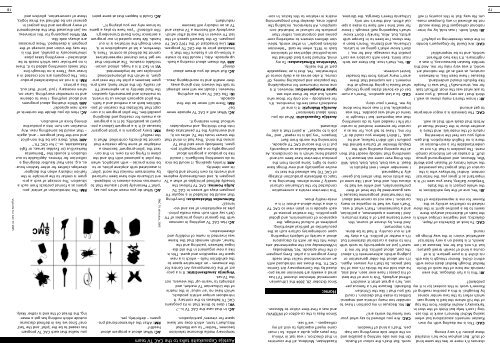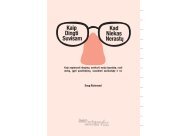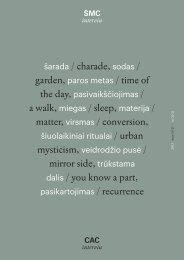interviu 2005 1 1 - Šiuolaikinio meno centras
interviu 2005 1 1 - Šiuolaikinio meno centras
interviu 2005 1 1 - Šiuolaikinio meno centras
Create successful ePaper yourself
Turn your PDF publications into a flip-book with our unique Google optimized e-Paper software.
19 18<br />
Vignette for CAC TV <strong>2005</strong><br />
AÈ: How do you decide the contents of<br />
each new episode?<br />
AM: While chatting about programs<br />
and about anything. I love to observe<br />
and to remember everything. Later on,<br />
when necessary, I just ‘print’ that out,<br />
like a printer.<br />
RM: It is not an industrialised production.<br />
The programs are not created in a<br />
linear way. There is no through-line<br />
that needs something added to it, there<br />
is no particular case which needs to be<br />
abstracted – everything takes place<br />
simultaneously in parallel, and this is<br />
the way the vision and concept of the<br />
program is developed. These processes<br />
are always web-like.<br />
VJ: While preparing for this interview,<br />
we just discussed that the development<br />
of every program and this project in<br />
general can be defined via three logics,<br />
those of conversation, pilotism and<br />
RM: The introduction of artists’ programs<br />
as a format protects from such a<br />
situation. The concept of such a program<br />
is similar to the principle in the<br />
fashion industry when the designer<br />
develops clothes for other fashion houses,<br />
e.g. Jean Paul Gaultier designing a<br />
collection for Hermes. Applicable to our<br />
situation it sounds like “Deimantas<br />
Narkevièius (or Evaldas Jansas, or Eglë<br />
Rakauskaitë, or...) for CAC TV.”<br />
AM: Well, there can be the non-pilot<br />
and not-the-final program – and, again<br />
– that would be something new. Any<br />
mutation can turn into a productive<br />
driving force of evolution.<br />
you realise that each CAC TV program<br />
has ceased to be the ‘pilot’ and the ‘last’<br />
one? Since we live in defined discourse<br />
outside which nothing has got a meaning,<br />
the threat of the end is rather likely.<br />
AÈ: Could it happen that at some point<br />
AÈ: What do you mean when you say<br />
‘pilot’? Personally (and I assume that to<br />
numerous movie-viewers in independent<br />
Lithuania who have been nurtured<br />
by mainstream movies) the word ‘pilot’<br />
is associated with airplane pilots, or to<br />
be more precise – with autopilot, when<br />
the pilot is poisoned with fish and the<br />
plane is flying on its own. In this context<br />
the ‘pilot-program’ becomes a<br />
metaphor of some huge creature that<br />
cannot be directly controlled. What is<br />
the reality?<br />
RM: Every program is a ‘pilot-program’<br />
because a) it is a program (about a program)<br />
as possibility; b) it is a program<br />
as a means for creating and designing<br />
possibilities. The pilot program is a concept<br />
that facilitates the creation of possibilities<br />
both as a method and a faith.<br />
The pilot approach allows us to invent,<br />
to maintain and permanently question<br />
the fluid identity in an ephemeral TV<br />
air reality. On the other hand, each program<br />
becomes a pilot for the next program,<br />
in which the aforementioned<br />
principles can be implemented.<br />
VJ: In fact it is a huge, almost uncontrollable<br />
creature. The attention that<br />
we get from channel representatives<br />
cannot be defined as control. There is,<br />
therefore, a lot of autopilotism in it,<br />
even though the initiative is in our<br />
hands. We have quoted in our program<br />
a sentence from David Cronenberg’s<br />
film eXistenZ: “you have to play a game<br />
to know why are you playing it”.<br />
AÈ: What about a program about<br />
health?<br />
RM: After the aforementioned programs<br />
– definitely, yes.<br />
ÐMC TV skirtukas, <strong>2005</strong><br />
AÈ: But what do you dream about<br />
doing?<br />
AM: We dream about creating a backup<br />
episode. Also, I would like to create<br />
a follow-up on a feature film that is<br />
broadcast prior to the CAC TV program.<br />
RM: Live broadcast of the 1972 CAC TV<br />
program. Or the farewell speech of the<br />
last TV viewer in the world after which<br />
everybody will become a TV maker and<br />
TV as an industry will become<br />
redundant.<br />
AÈ: What will a CAC TV episode never<br />
be?<br />
RM: There will never be the first<br />
episode.<br />
IK: The CAC TV can be anything.<br />
However, I doubt we will ever attempt<br />
to talk the viewers into giving away<br />
their wealth and to worshipping Jesus…<br />
AÈ: Has CAC TV anything in common<br />
with the general ruling principles of TV<br />
(let’s say with such mass media principles<br />
as exploitation of sex and violence)?<br />
Raimundas Malašauskas: Everything<br />
that would be included in a regular TV<br />
program stays off screen in CAC TV.<br />
Julija Fomina: CAC TV follows the<br />
broadly defined principles of what a TV<br />
program is, and simultaneously explores<br />
and invents its own format and builds<br />
its own identity.<br />
AM: Frankly speaking, it would be nice<br />
to do something hooliganic. I would<br />
like to produce a program about<br />
pornography or a pornographic program.<br />
Somebody once said that TV<br />
screws the mind. They had in mind that<br />
the viewer trusts the TV, relies on it,<br />
and eventually the TV penetrates deep<br />
into their thinking, and manipulates<br />
without them realising it.<br />
AÈ: In that case the CAC TV is...?<br />
VK: I dare to think that in its programs<br />
CAC TV behaves to the contrary. It<br />
introduces unique artistic products,<br />
which have no ‘air value’ in the matrix<br />
of the Lithuanian TV market, and<br />
attempts to ‘warm-up’ the viewers, not<br />
the TV-set.<br />
Virginija Januðkevièiûtë: It is a project<br />
of the Contemporary Art Centre for<br />
the airwaves – an alternative space to<br />
the exhibition halls – which is a new<br />
space for exposition and quest. This is<br />
like a new argument in the old dialogue<br />
between ‘painting and the<br />
frame’, which reminds that the frame<br />
was invented in name of mobility and<br />
dissemination.<br />
temporary media discourse television<br />
becomes “hotter” to use Marshal<br />
McLuhan’s term, which does not leave<br />
space for viewers’ participation.<br />
Austëja Èepauskaitë talks to the CAC TV team<br />
Austëja Èepauskaitë: What do you<br />
think about television?<br />
Aurelija Maknytë: It is one of<br />
mankind’s most terrific inventions. It’s<br />
for everybody – not only for those who<br />
watch, but also for those who see.<br />
Ignas Krungelevièius: However, it is<br />
one more instrument for manipulating<br />
the populace and producing money. Of<br />
course, it also serves as a daily source of<br />
information. Yet, that is an inseparable<br />
part of the reality.<br />
Valentinas Klimašauskas: To my<br />
mind, Richard Serra best defined the<br />
socio-political objectives of television<br />
back in 1973, when he said: “television<br />
delivers people”. In other words, television<br />
delivers viewers to marketing companies<br />
and corporations, rather than<br />
products for cultural or industrial consumption.<br />
All televisions, including the<br />
public ones, develop their programming<br />
matrix in relation to this factor. In con-<br />
This interview revisits a conversation<br />
conducted for the Lithuanian cultural<br />
weekly 7 <strong>meno</strong> dienos. Returning to a<br />
topic (a deliberate production strategy<br />
of CAC TV) has allowed the text to<br />
evolve organically and new things have<br />
come to light. Some points from the<br />
previous interview have been cut-andpasted<br />
here; which is no coincidence. As<br />
Raimundas Malašauskas so eloquently<br />
put it in the second CAC TV episode,<br />
borrowing the words from Bart<br />
Simpson: “my job is to repeat” and “my<br />
job is to repeat”. A point that is also<br />
discussed.<br />
Since October 20, 2004 the Lithuanian<br />
commercial television channel TV1 has<br />
aired a weekly art-television series produced<br />
by the Contemporary Art Centre:<br />
CAC TV. The shows are introduced with<br />
an unconventional trailer that reads:<br />
Every program is a pilot. Every program<br />
is the final episode. Yet, Wednesday<br />
in/Wednesday out the experimental arts<br />
show hits the air with its discussions<br />
about a variety of subjects impacting<br />
upon contemporary culture such as the<br />
peculiarities of political advertising,<br />
problems of cultural heritage, the<br />
expansion of consumerism, and global<br />
geo-politics. The creative process of<br />
each episode is in plain view so CAC TV<br />
is also a show-about-a-show: it is a<br />
meta-reality show.<br />
Home:<br />
Simon Rees is the co-editor of INTERVIU<br />
and was a first-time visitor to Moscow.<br />
Kazakhstan, Moldova, all the countries<br />
in that direction. I was last in Vilnius<br />
five years ago, quite a while. So I must<br />
come myself especially to visit all my<br />
colleagues… we’ll see.<br />
JB: Yes, that’s true. But there are technical<br />
limits. Even with curators we can’t<br />
predict the coverage. And for me, I<br />
don’t know what’s going on in Latvia,<br />
Lithuania, and Estonia. There’s been a<br />
few shows I’ve been to in Europe with<br />
artists, but. Also, frankly I don’t know<br />
what’s happening well enough. I know<br />
for next time I will have to make a special<br />
effort. And there’s not only<br />
Lithuania there’s Georgia, the Ukraine,<br />
CAC: So a last question. There’s a number<br />
of ex-Soviet states going through<br />
what Russia is going through at the<br />
moment. I am surprised that there<br />
aren’t many artists from the broader<br />
Soviet universe.<br />
JB: No. Because in my position I have to<br />
consider too many criteria and responsibilities<br />
to make that decision. I could<br />
tell you that I like the Christian<br />
Boltanski. Because he’s a famous person,<br />
he’s a great artist it wouldn’t<br />
offend anybody. This is one of the best<br />
of his pieces I have ever seen. And also,<br />
he also told me he thinks it’s one of his<br />
best pieces. So that’s my answer. Again,<br />
it’s not about the older generation or<br />
judging artistic achievements it’s about<br />
the past, about politics. But for me it<br />
wasn’t just an opportunity to work with<br />
him to make a curatorial statement but<br />
it’s a matter of politics. It’s a duty for<br />
art in our country. It had to be done.<br />
He’s important.<br />
And then, by chance of course, this<br />
event became part of a State structure.<br />
And I became a spokesman, a politician,<br />
and a businessman. That’s what it was.<br />
That’s why we had to organise so many<br />
curators. I was not so concerned about<br />
the international programme because it<br />
was guaranteed by the level of their<br />
professionalism, and while we had to<br />
discuss this, and that, and I like some of<br />
the artists more than others but generally<br />
it happened.<br />
I remember when I met Kæstutis in<br />
Basel. It was blah, blah, blah, blah. Will<br />
this thing ever come out because it’s<br />
something that nobody needs? But then<br />
at the opening standing with the<br />
Deputy Minister of Culture behind the<br />
podium I still didn’t believe, and he<br />
said, “I didn’t believe you could do it”.<br />
For me, I have to tell you, for me as a<br />
curator for someone involved in curatorial<br />
life I needed only to do something<br />
that was important: but I thought in<br />
terms of what was possible. This was<br />
impossible, but it was some how done<br />
by me. There’s your story.<br />
CAC: Are you allowed to say what your<br />
two favourite works are?<br />
work. But that’s the colour of Russia.<br />
On the one side nothing is possible and<br />
on the other side everything can happen.<br />
That’s a kind of freedom.<br />
JB: Well, both. I was told, by my international<br />
colleagues that these would<br />
not be allowed in any European museum.<br />
No way. But in this country it will<br />
CAC: Are David Ter-Organyan’s bombs<br />
in the show threatening or playful?<br />
JB: I know there’s many shows as well. I<br />
think that I am very proud. If you were<br />
to ask what was the most difficult task<br />
for me, structurally? That was it. People<br />
like Kæstutis should understand.<br />
Because I have been like, in-between<br />
curators, as well as all the national art<br />
world, it was very risky for me. And this<br />
terrible Russian bureaucracy, it was a<br />
nightmare. It’s like two different<br />
worlds, and to be responsible!<br />
CAC: The biennale is a major enterprise<br />
to get around.<br />
JB: Yes, one of the key exhibitions in<br />
the whole project is in the State<br />
Tretyakov Gallery, have you seen it? It is<br />
important as it gives you the historical<br />
context. Andrei Yerofeyev who is the<br />
curator of that project has presented<br />
the whole history of Russian post-World<br />
War, Moscow, and underground group<br />
stuff. It creates an art historical compliment.<br />
The problem is that it’s not so<br />
understandable for a non-Russian as<br />
there is no English description. But generally<br />
you can feel the interesting<br />
nature of the materials. And there is<br />
another show in the Central House of<br />
Artists that deals with that as well.<br />
CAC: To look at Dialectics of Hope,<br />
dialectics, and negative critique which is<br />
the basis of dialectical analysis there<br />
seems to be a positive spirit in the show<br />
related to collective activity so the<br />
Rovner for me is representative of this.<br />
JB: This is a fair dialogue. She even<br />
reminds me here of the work of Shirin<br />
Neshat though Neshat deals more with<br />
ethnic cliché. Rovner though is less ethnic<br />
cliché it is pure gesture. It is of<br />
course a kind of Jewish Israeli gesture:<br />
but it’s not. But for me, because as I am<br />
Jewish, it is based on a very historical<br />
aesthetical vision: in the way things go<br />
round.<br />
CAC: This is me dealing with my own<br />
Russian romantic associations but when<br />
seeing Michel Rovner’s work in this setting<br />
I can’t help but think of the shot in<br />
Tarkovsky’s Andrei Rublev from the top<br />
of the hill where the bell is being cast<br />
which refers to the two winter scenes<br />
by Breughel. Is this a positive reading of<br />
Rovner’s work in this context (or is it my<br />
problem)?<br />
chances it’s more or less the same kind<br />
of stuff. But anyhow how he’s installed<br />
these pieces: it’s very strong.





